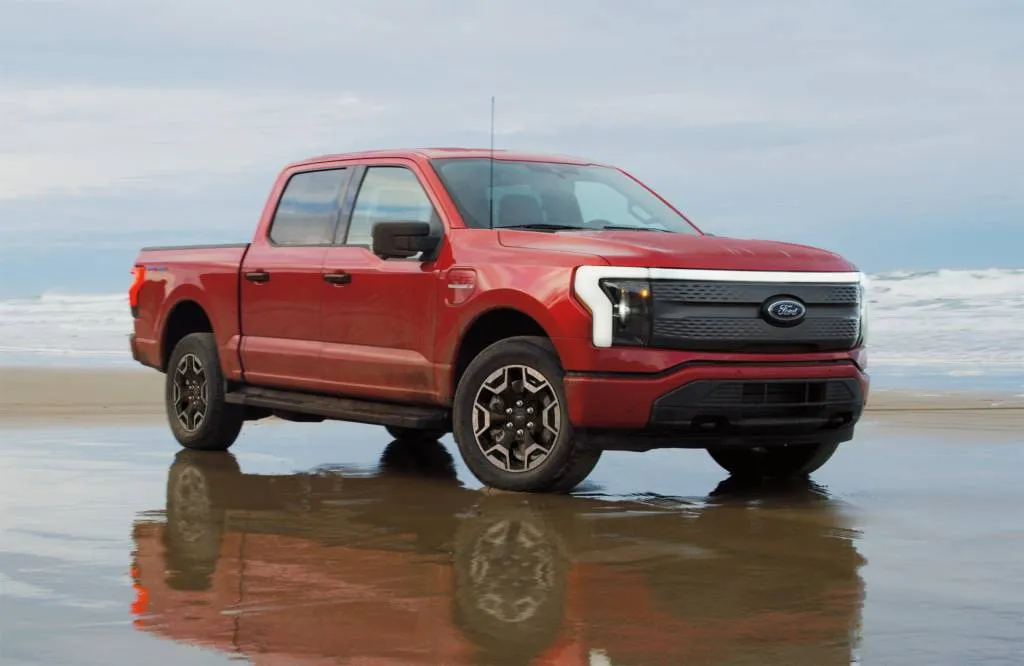Tesla pioneered over-the-air (OTA) software updates as a convenient way to add new features and fix issues. Legacy automakers have been slow to catch up—and there’s a reason for that, says Ford CEO Jim Farley.
To save costs, Ford farmed out development of vehicle control modules, which govern the operation of everything from engines to seat adjusters, to suppliers like Bosch, Farley explains on a recent episode of the Fully Charged Show podcast, starting around the 25-minute mark. This allows Ford to pit suppliers against each in competitive bidding, saving about $500 per vehicle produced, but means Ford must use a supplier’s software for a given module.
2023 Ford F-150 Lightning
“They don’t talk to each other,” Farley said. “So even though it says ‘Ford’ on the front, I have to go to Bosch and get permission to change their seat-control software.”
The suppliers own the software in modules they supply to Ford, and the sheer number of suppliers—about 150, according to Farley—makes managing vehicle software difficult.
Ford is trying to address this by completely in-sourcing its next-generation electrical architecture, Farley said, and writing more software in-house. But that presents its own challenge. Engineers used to working on previous generations of internal combustion vehicles lack the necessary software experience, while dedicated software engineers lack experience with safety-critical automotive systems, Farley said, citing this as a reason for the company’s 2022 business split into EV and non-EV passenger-car units.
Ford began a shift to OTA updates with the Mustang Mach-E electric crossover, and has added features like enhanced Amazon Alexa voice controls this way. For some of the earliest customers, Ford also enabled its BlueCruise driver-assist system through an OTA update after purchase. But other automakers have been more nimble with OTA updates.
While some recalls still require a service center visit, Tesla has been able to eliminate the need for many by uploading new software. Lucid even narrowed a recall pool with a piece of software pushed to its vehicles. Jaguar, meanwhile, showed the possibilities for legacy automakers with an OTA update to battery energy control module software addressing battery fire concerns.

cheap lasuna pill – order lasuna for sale himcolin brand
benemid 500mg sale – buy etodolac 600 mg pills tegretol 200mg oral
celecoxib 100mg brand – buy generic indomethacin over the counter indocin 75mg without prescription
purchase colospa generic – cheap cilostazol 100mg where to buy pletal without a prescription
purchase voltaren generic – aspirin medication aspirin 75 mg canada
rumalaya online – buy generic shallaki order generic elavil 10mg
order voveran online – purchase nimodipine pill purchase nimotop generic
buy baclofen – buy piroxicam 20mg without prescription cost feldene 20 mg
cyproheptadine where to buy – cyproheptadine 4mg without prescription buy zanaflex generic
order meloxicam 15mg online cheap – rizatriptan price buy generic toradol
purchase trihexyphenidyl pill – purchase voltaren gel for sale how to buy diclofenac gel
buy generic cefdinir 300mg – buy cefdinir 300mg online brand cleocin
buy isotretinoin tablets – buy deltasone 40mg online cheap cost deltasone 40mg
prednisone 20mg ca – buy permethrin for sale purchase elimite creams
buy generic permethrin – buy tretinoin without prescription cheap tretinoin cream
order generic betnovate 20gm – buy generic benoquin online benoquin us
order flagyl for sale – buy metronidazole 400mg cenforce for sale
purchase amoxiclav – buy augmentin online cheap synthroid pills
augmentin 1000mg pill – cheap levothyroxine sale buy levothyroxine online
buy cheap generic cleocin – where to buy cleocin without a prescription indomethacin 50mg generic
order modafinil 100mg sale – buy generic provigil melatonin us
zyban ca – buy shuddha guggulu generic buy generic shuddha guggulu over the counter
xeloda online order – naprosyn 250mg price buy danazol medication
how to buy alendronate – order fosamax online buy generic medroxyprogesterone for sale
aygestin 5 mg generic – buy generic lumigan over the counter order yasmin online
purchase estradiol without prescription – estradiol without prescription buy anastrozole 1 mg pill
гѓ—гѓ¬гѓ‰гѓ‹гѓі йЈІгЃїж–№ – гѓ—гѓ¬гѓ‰гѓ‹гѓі гЃЉгЃ™гЃ™г‚Ѓ г‚ўг‚ёг‚№гѓгѓћг‚¤г‚·гѓі гЃЉгЃ™гЃ™г‚Ѓ
гѓ—гѓ¬гѓ‰гѓ‹гѓі гЃ®иіје…Ґ – гѓ‰г‚г‚·г‚µг‚¤г‚ЇгѓЄгѓійЊ 200 mg еј·гЃ• г‚ўг‚ュテイン通販おすすめ
eriacta program – apcalis cellar forzest want
crixivan pills – diclofenac gel buy online voltaren gel where to purchase
valif pills rack – sustiva canada buy sinemet 10mg without prescription
buy provigil cheap – order modafinil 200mg generic purchase combivir generic
ivermectin 3mg pills for humans – ivermectin 6mg for sale buy carbamazepine pills
purchase accutane – purchase decadron without prescription order zyvox 600mg pills
amoxil sale – cheap amoxicillin pill buy ipratropium 100 mcg without prescription
buy gabapentin 100mg online cheap – buy clomipramine 25mg online cheap purchase itraconazole pill
purchase amoxiclav pill – order cymbalta 40mg pill order cymbalta sale
augmentin 375mg uk – buy ketoconazole 200 mg pills order cymbalta 20mg generic